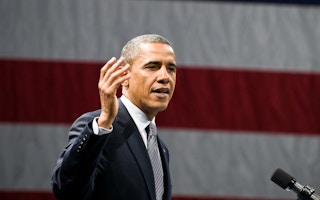The day after his 2009 inauguration, President Barack Obama committed to “creating an unprecedented level of openness in government.”
He vowed to build on “transparency [that] promotes accountability by providing the public with information about what the government is doing,” “participation [that] allows members of the public to contribute ideas and expertise,” and “collaboration [that] actively engages Americans in the work of their government.”
Despite these promises, and despite longstanding requirements of administrative law, the Obama administration is making significant regulatory decisions behind closed doors — without transparency or public involvement. Yet these new regulations could have enormous impact on Americans for generations to come.
The president’s ambitious regulatory agenda to address climate change relies on a “social cost of carbon” (SCC) — an estimate of the monetary value of eliminating one ton of CO2emissions — to calculate the benefits used to justify a host of regulatory actions and government subsidies. These include renewable fuel and mileage mandates for our cars, water limits for washing machines and dishwashers and less visible rules that will likely affect the price of food and electricity.
Rather than working openly with experts and the public to develop this key metric, the administration quietly released a revised SCC in May as a fait accompli. The new SCC is $41 per ton — almost double the value that the administration set in 2010.
“
The social cost of carbon’s influential role in a variety of future policies, as well as the difficulties and uncertainties of calculating the SCC, demand conscientious attention — including public comment and peer review — to the task of getting it right.
This revised social cost of carbon first appeared in a “technical support document” produced by an interagency working group. Since then, the SCC has been used to justify new regulations that the government estimates will cost Americans hundreds of millions per year — including new efficiency standards for major appliances and revised power plant rules.
The United States releases more than 5 billion millon tons of CO2 per year, so the new SCC of $41 per ton amounts to an increase of about $100 billion per year in the total social cost of US CO2 emissions.
If Congress had enacted a carbon emissions tax to address climate change, this revision would amount to a trillion-dollar tax increase over the next decade. Instead, this trillion dollars will be placed on the scales of benefit-cost analysis — weighing in favor of expanded regulation by the Department of Energy, the Transportation Department, the Environmental Protection Agency and all the other federal agencies engaged directly or indirectly in climate policy.
The implications for the economy are troubling, particularly since, according to the administration, only seven per cent to 10 per cent of those benefits will accrue to US citizens. The vast majority of the benefits will go to other nations — while we bear all the costs.
The SCC is not a bad idea in principle. To the climate, all CO2 molecules look alike, so any cost-effective collection of carbon-reduction policies must have the same implicit marginal cost. The effect of CO2 emissions on global climate systems is independent of the source of the emissions, so using one set of SCC values across the government can discourage agencies from trying to outbid each other in their efforts to save the planet.
Nonetheless, the SCC’s influential role in a variety of future policies, as well as the difficulties and uncertainties of calculating the SCC, demand conscientious attention — including public comment and peer review — to the task of getting it right.
Should benefits to other nations be included in the value, even if they don’t reciprocate? What is the appropriate discount rate for considering effects that may occur far in the future? What do different economic models tell us about SCC values?
The process of scientific inquiry revels in debate, discussion and discourse. Public comment and peer review of how the government selected, weighed and combined the integrated assessment climate models; what those models mean, and the appropriateness of the various assumptions made to deal with economic and scientific uncertainty will not only add credibility to future government climate policies, but encourage advances in scientific understanding of these complex issues.
By releasing the SCC as a fait accompli, the administration has denied non-governmental experts and the public the opportunity to weigh in. It undermines the president’s promises for open government and established administrative policies.
In addition, it drives regulatory decisions affecting prices of fuel, electricity and consumer goods that could have serious ramifications for the economy — and the well-being of Americans today and into the future.
Susan E Dudley, director of the George Washington University Regulatory Studies Center, served as administrator of the Office of Information and Regulatory Affairs, 2007-2009. Brian F Mannix, visiting scholar at the George Washington University Regulatory Studies Center, served as associate administrator of the Environmental Protection Agency, 2005-2009. Sofie E Miller is a policy analyst at the GW Regulatory Studies Center, and editor of its Regulation Digest. This post originally appeared in Reuters.










